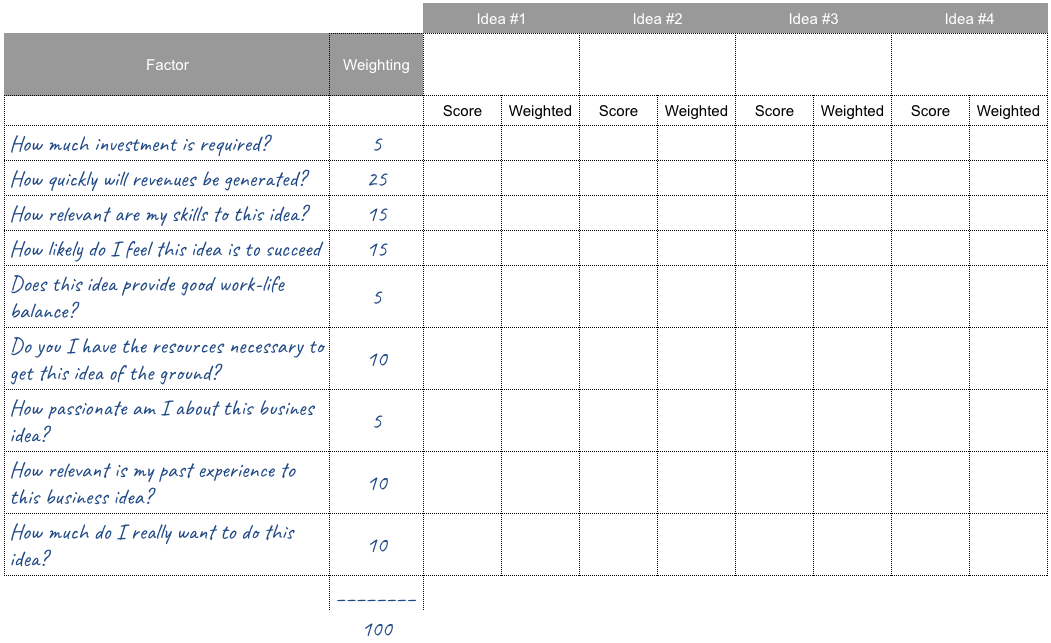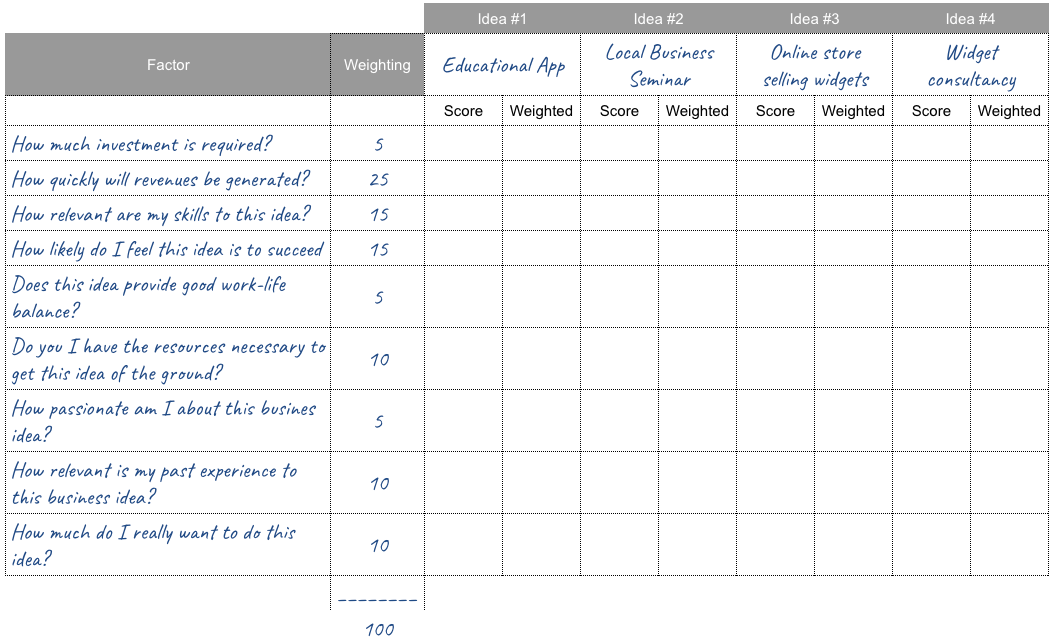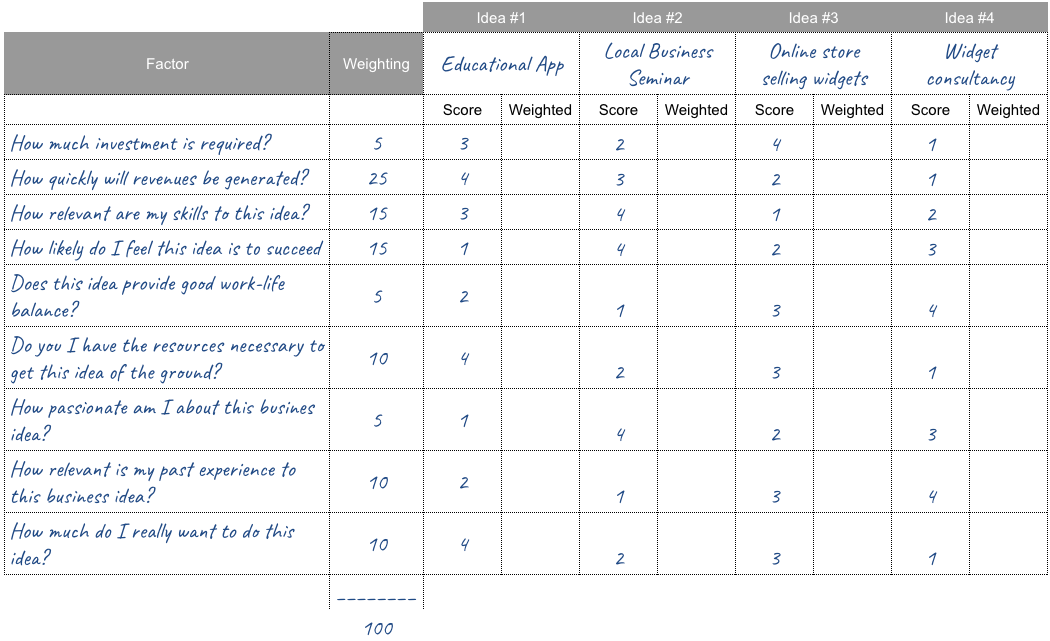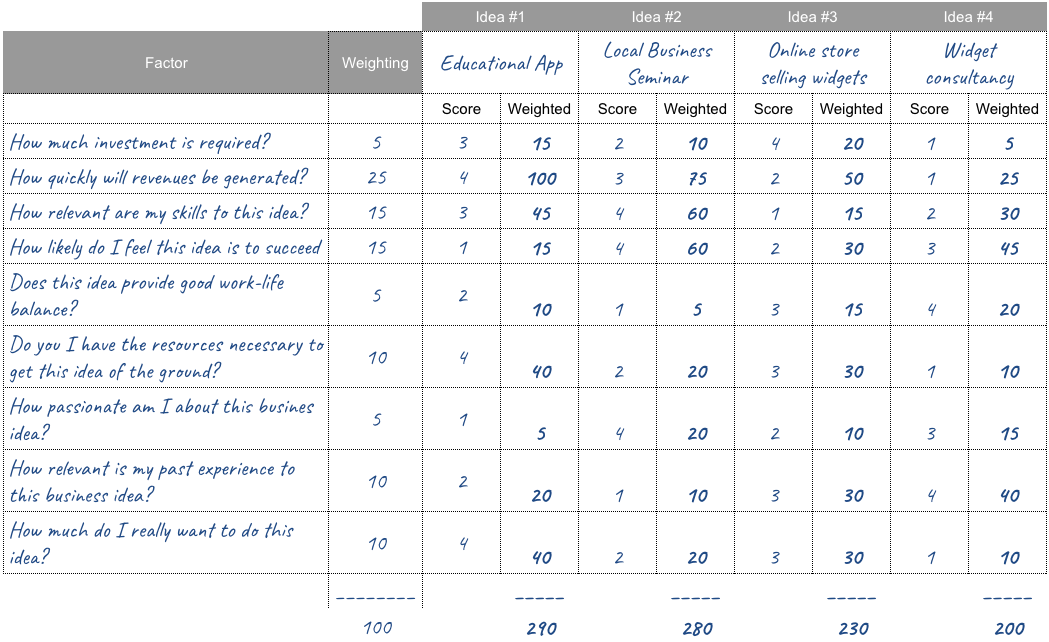We use cookies to give you the best experience of our website. Click for more info

Step 2 - Rank your ideas to discover the ones with most potential for you
Next you need a way to figure out which ideas are bad, which are okay, which are good, and which ones are freakin' awesome and have real potential. You do this by ranking them.
How you rank your ideas is very much a personal thing as everyone has different needs and wants and ways of working.
At different times in your life, and at varying stages in your business career, some factors will have more importance than others.
For example, if you are fresh out of university and looking to set up your first venture, factors such as quick revenue generation might have more importance than good work life balance. Conversely, if you have been working for several years and built up some savings that could help fund a business, but you are newly married and have just had your first child, then generating a quick return might take a back seat to having a good work life balance.
The important thing is that there are no right or wrong factors. It is all personal. The same is true with the way you rank the importance of the factors (more on that in a moment).
Here are ten typical factors that you might want to include on the list you use to rank each idea:
- How much investment is required?
- How quickly will revenues be generated?
- How large are the potential returns?
- How relevant is my skill set in relation to this business idea?
- Do I have the resources necessary to get this idea off the ground?
- How well does this idea score in terms of work-life balance?
- How passionate am I about this business idea?
- How likely is this idea to succeed?
- How relevant is my past experience to this business idea?
- How much do I really want to do this idea?
Choose the factors from this list that are important to you at your current stage in life and add any factors to the list that you feel are important, but that I have not included above.
For this step you might want to create a spreadsheet, but feel free to use pen and paper if that is preferable for you.
In the first column write the list of factors that are most important to you.
In the second column you need to give these factors an importance weighting. The simplest way is to do this from 1 to 10 where 10 is the most important factor and 1 is the least important factor. However, I tend to allocate a number of points to each factor out of a total of 100. If you take a look at the second column in the table below you will see what I mean.

As you can see, the Weightings column add up to 100.
I gave 5 of these 100 weighting points to How much investment is required as in this example I'm assuming there's plenty of money available and so it isn't an important factor.
Below that is How quickly will revenues be generated and I have given that 25, which is a quarter of the total weighting points available, so clearly this is a very important factor for me, in this example. I'm pretty sure you'll be able to figure the rest out.
At the top of all the rest of the columns write the title of each of the ideas that you are considering from Idea #1 through to Idea #10. Have a column for however many ideas you want to analyse. I didn't want to cram too my ideas into this example for clarities’ sake, as it would have required a very small font, so there are just four ideas, but feel free to include as few or as many as you like.

Underneath each of those ideas give a score, out of 5, for each of the factors listed to the left. This might sound complicated, but it isn't. Just look at the completed table below and you will see just what I mean. If I am working with four ideas I tend do give one of the idea 4, then one of them 3, another 2 and the final idea would get just 1 point. If there were 10 ideas this would be 10, 9, 8, 7, etc, down to the worst idea (as far as this particular factor is concerned) getting the 1.

For example, for the How much investment is required? factor we've score the Online store selling widgets idea as the top scorer with 4, because that requires the least amount of investment and so is the most preferable. The Educational App gets 3 points as that requires the second least investment, the Local Business Seminar gets 2 points and Widget `Consulting idea gets the lowest score of 1 as that requires the most investment as it requires a dedicated office and several staff members.
Work your way down the list of factors you’ve written down in the left hand column and rate each idea accordingly. Remember that your rating is from most favorable to least favorable, so the most favorable gets the highest score and least favorable gets the lowest score. So for that second factor, How quickly will revenues be generated, the Educational App gets the best score as I feel it is going to generate revenues the quickest, and the Widget Consulting idea gets the lowest score of 1 as I feel that will take the longest to start generating revenues.
And the penultimate step is to multiply the weighting factor you wrote in column 2 and write the total just to the right of the scores you have given for each idea. I've written these in slightly bolder so you can see them easier.
Finally, at the bottom of each of the idea columns write in the total for the all the ratings above. If you are doing this in a spreadsheet that will be simple enough, but if you are doing it with pencil and paper and if you're not a mathematical whiz, you might need to grab a calculator.
Here's what your finishing table should look like.

Although this sounds like quite a bit of work it really is a pretty quick and easy process. After you've done it once you'll have mastered the art of ranking ideas using weightings.
This is a great skill to have as it allows you to quickly and easily filter out the half-baked ideas and focus your attention and energies on the most deserving of ideas and the ones which, in all likelihood, have the most potential. To use a Biblical reference, you're separate the wheat from the chaff.
This ranking system is particularly powerful at highlighting ideas that you might not originally have considered as being a great one to pursue. Often there is real gold hidden away, and it takes a system like this to bring its potential to the forefront.
Now that you've got all of that mathematics out of the way you can get down to the serious business of reviewing which idea, or ideas, you should be moving forward on.
Recommended Reading

One tool I couldn’t live without
If you are not already making good use of Evernote (or something very similar) you really need to take a look as Evernote can be a repository for pretty much everything in your life.
New Course
Check out the soon to be released Secrets of a 7-Figure Online Entrepreneur.
My Favorite Tools
Discover the tools and services I’ve used over the years.
Have me on tap
How would you like have me on your team whenever you need me and at a price you can afford.
About Me
Since graduating from university I have started five seven-figure businesses and now I want to share that passion for ideas and business with you and to help you to transform your ideas into reality.
Follow Me
(c) 2019 Paul Smithson